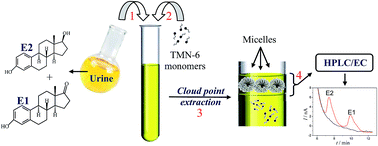Development and application of a cloud point method for the extraction of natural estrogens E1 and E2 from urine samples and their simultaneous determination by HPLC-EC using a BDD electrode†
Abstract
The cloud point extraction (CPE) method was developed to extract and preconcentrate estrone (E1) and 17β-estradiol (E2) hormones from human urine. These hormones were detected and quantified using a combination of the techniques of high-performance liquid chromatography and electrochemical detection (HPLC-EC). A boron doped diamond (BDD) electrode was cathodically pretreated and used as the electrode material for all the electrochemical measurements. Limits of detection (S/N = 3) of 57.1 ng mL−1 and 53.4 ng mL−1 were obtained for E1 and E2 hormones, respectively. Extraction solvent volumes were changed in the 0.5–2.5 mL range, and optimum results were obtained when using 1.0 mL of nonionic Tergitol TMN-6 surfactant. A comparison was made of the efficiency of the CPE method and that of direct liquid–liquid extraction (LLE), using CCl4 as the organic solvent, which clearly indicated the superiority of the CPE method over LLE. The proposed method was validated based on fundamental parameters such as selectivity, accuracy, precision and recovery, and was successfully applied to individual urine samples collected from a man, a pregnant woman, a woman of fertile age, and a lactating woman.



 Please wait while we load your content...
Please wait while we load your content...